The Harmonic Principles™:
Experiential Harmony
By Valerie Jardon | Strategy Director
& Dr. Sally Augustin, PHD | Director of Research
This is the second in a series of three posts that explore in greater depth our introduction to the nine Harmonic Principles™, IA’s seminal framework for aligning strategy, design, and science in concurrent harmony for any environment. The principles are bundled in groups of three under each of the Harmonic Dimensions: Spatial, Experiential, and Relational.
Your Harmony Revealed
Explore which Harmonics could be most impactful for your organization.
We have created a short quiz to explore which of the Harmonics could be the most impactful for your organization, elevating the environment and culture. Please click the link below, take the quiz, and receive your personalized Harmony Revealed one-pager, which will include insights unique to your responses.
The Dimension of Experiential Harmony
The second dimension of Harmony, explored in this post, unveils the elements that supercharge positive moods and experiences in sensory-rich spaces to provide satisfaction, vibrancy, and reflection. Through deliberately crafted sensory environments, Experiential Harmony creates magnetic spaces that enhance organizational and individual performance by creating compelling environments where people can achieve their fullest potential professionally and socially.
Within this dimension are the principles of Salient Features, Sensory Richness, and Sustainable Revitalization focused on experiential factors that create truly harmonic, healthy, and dynamic environments. Their application to design is pragmatically measurable—each principle paired with a trackable set of outcomes that builds a compelling scenario around benefits and the costs of investment.
As noted in previous posts, the principles are underlined by years of research and development in neuroscience, anthropology, sociology, psychology, and more specifically on research conducted largely in the last decade that identifies the sensory, cognitive, emotional, and motivational processes that generate responses to design.
Salient Features
The principle of Salient Features refers to carefully selected elements that intuitively guide attention and enhance constructive in-space experiences. This is design for satisfaction, which lays the foundation for solo and team performance at full potential. Psychological and physical well-being are simultaneously optimized when user satisfaction and identification with place increases through positive non-verbal messaging and the alignment of user activities with design.
By establishing a visual hierarchy of design elements and contrasts that enhance spatial awareness, Salient Features direct user attention, making spaces more memorable. Research shows that the human brain notes intentional visual contrasts/features that stand out from their surroundings. This is particularly relevant for retail environments where repeat client visits are built on positive memorable experiences.
A feature can be an impressive and beautiful art piece at the end of the hall or another type of dynamic element or impactful brand moment. These elements can be delivered in a variety of ways from sculptures to digital water features to more subtle distributed elements, including layered patterns and colorful words. The perfect solution depends on the type of environment and the intended effect which can be strong and vibrant or gentle and soft.
Moreover, a memorable design component can be temporary but still have an impact. While a permanent installation will be effective over time, a short-term or pop-up installation can support a current initiative, enterprise milestone, product launch, or event.
Opportunities to create memorable experiences through salient features are many and varied. A bit of mystery and intrigue, for instance, referring back to the 14 patterns of biophilic design, can inspire higher levels of satisfaction, a sense of ownership, and identification with place, creating positive outcomes in workplace, retail, or hospitality environments. Features involving the sense of touch can be particularly potent, attracting attention and interest. A kinetic element offering hands-on engagement, especially when shared with others, builds a heightened sense of community. In a retail environment, it has the potential to lead to increased sales.
Intentional design can spur positive experiences that support self-esteem, elevate nonverbal messaging, and enhance creativity and interactions with others. These factors are critical for any environment but especially meaningful for a remote workforce returning to the workplace or visitors experiencing an environment for the first time. Increased levels of satisfaction and identification with place are the measure of Salient Features.
An example of salient features from our portfolio is a three-floor conference center that accommodates the traveling and local team members of a confidential client. The objective was a highly engaging, colorful, and experiential space that would be memorable and almost transportive, especially for those spending a long day there.
The design creates moments of surprise, taking advantage of the play of light through large exterior windows, designed lighting, and an emphasis on geometry and the shock of color—an orange-red stair connects the three floors, each offering a variety of workspaces with a different feel.
Throughout, strong environmental graphics play with color, geometry, and light. The construction and placement of the walls at the top of the stairs, for instance, create a three-dimensional zigzag pattern in the corridor. The walls, faced with geometric shapes using sheens and acrylics interact with light from oversized rectangular and secondary lighting fixtures at the ceiling, ensuring the corridor is perceived differently from morning to midday to evening.
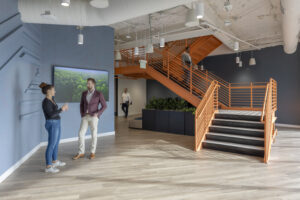
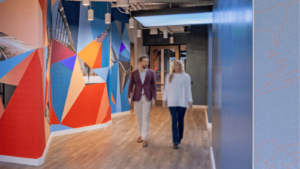
Confidential Client, Denver, CO | Photography by Frank Ooms
For another confidential client, an added interconnecting stair establishes a central zone and pathway with ceiling treatments and lighting inspired by the nearby Chicago River. Floor graphics, zoning, and color blocking for workplace neighborhoods are based on Chicago neighborhoods, with imagery and subtle architectural gestures suggesting what you might see in the city. This design approach not only creates memorable features but satisfies the frequent client request to showcase an organization's regional location in a special way without undermining the overall brand.
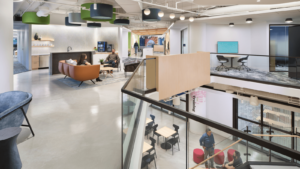
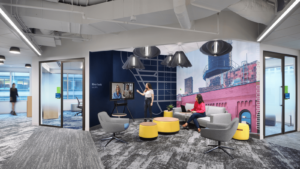
Confidential Client, Chicago, IL | Photography by Patsy McEnroe
For many clients, the nonverbal messaging of color coding as a significant design feature contributes to easy navigation and is a key component in creating a communicative, comfortable, and inspiring environment.
Sensory Richness
The principle of Sensory Richness refers to varied sensory experiences that elevate users’ moods. This is design for vibrancy, taking mood to a higher level.
Science confirms that a good mood encourages optimal workplace performance—as well as sales in retail environments and satisfaction in hospitality environments. Layered multi-sensory experiences that engage users have the ability to create positive emotions that support cognitive performance, social connections/cohesiveness, and creativity. Stimulation of the senses that connect people based on shared affinities and preferences contribute to the meaning and impact of their experience, creating memories and inspiring engagement with the mission and community of the organization and its built environment.
Sensory Richness need not be in your face. Creating the right amount of sensory excitement in scale and quality to achieve a targeted attention level without overwhelming users depends on intent and objectives. High stimulation, for example, might be appropriate for some retail spaces but overwhelming for others. Providing a variety of sensory approaches is critical for success in workplaces and hospitality environments alike.
Typically, users in any environment will choose one sensory experience over another based on their activity and objectives. Choice is essential. With choice, the reward sections of the brain light up, creating another positive benefit.
Sensory Richness also addresses sensory-related complaints about visual, acoustic, and thermal distractors. There are many ways to ensure sensory comfort, including adjustable thermal controls, carefully designed acoustics, lighting options, and zoning that let users identify the most comfortable and best-suited areas for their preferences and tasks.
Demographics is another key factor; age is a good example. Older people generally require more illumination and larger print for signage. This is particularly relevant for retail and hospitality environments because users may retire from the workplace but will continue to shop and are likely to travel during their lifespan.
An immersive digital experience is an additional option gaining popularity in workplace, retail, wellness, and museum environments. During these events, participants engage more fully with the subject of the immersion for a heightened personal and internalized experience. Displays and vignettes can also be meaningful.
From our portfolio, drawing on Sensory Richness, data cloud company Snowflake capitalizes on its name with a sense of fun. Complementing a custom iceberg-style desk, the sounds of winter are piped into the lobby. Moreover, on a wall in the lounge, many of the world’s highest mountains, known for their snow-capped peaks, are graphically depicted.
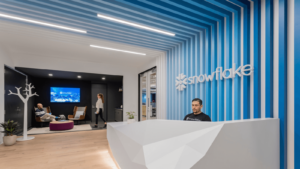
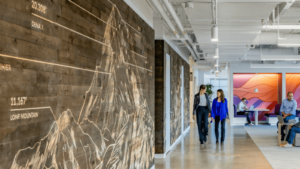
Snowflake, Dublin, CA | Photography by Emily Hagopian/Hancock
At DraftKings headquarters in Boston, a focus on sports to define space engages the senses with color and architectural elements that experientially connect with the organization’s mission to deliver fantasy sports, iGaming, and more.
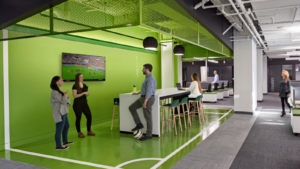
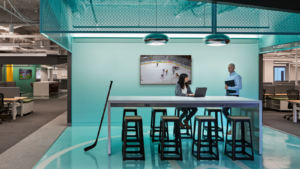
DraftKings Headquarters, Boston, MA | Photography by Robert Benson
An emotionally satisfying environment that positively supports teamwork by stimulating the senses and inspiring engagement, as well as a reduction in sensory-related complaints, are measures of Sensory Richness.
Sustainable Revitalization
Sustainable Revitalization refers to spaces and practices that nourish users for mental refreshment. For a sustained impact, it includes absorbing contact with nature or people, hands-on creative moments, physical exercise, or self-reflection. This is design for reflection.
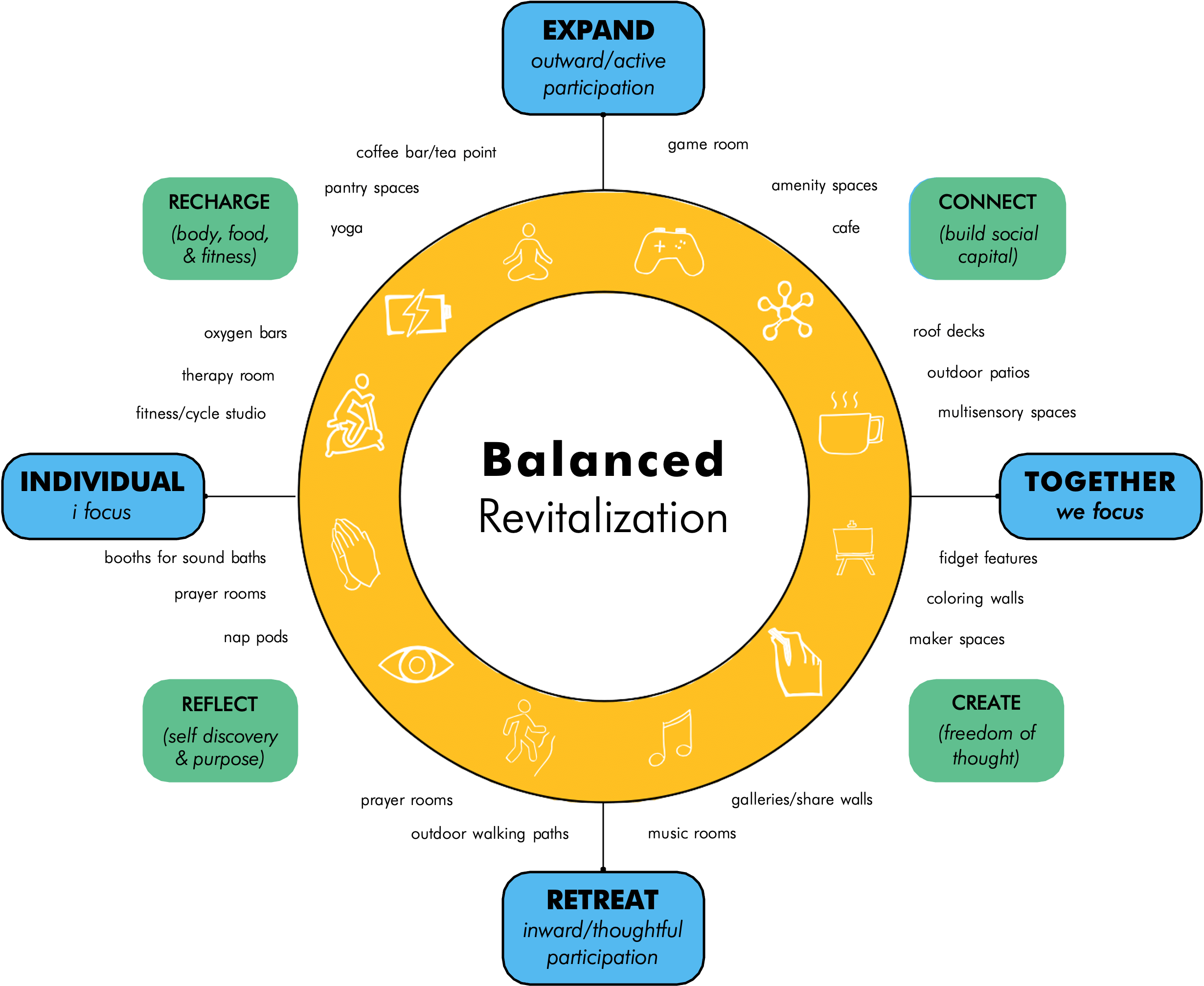
Augustin & Oseland (Eds.), (2024,) Science of People and Office Design, Routledge, Chapter 13.
Sustainable Revitalization focuses on designing experiences that allow people to mentally revitalize to ensure a long-term connection to their roles and activities in the workplace. It also addresses burnout.
Toward that goal, research confirms what is now common knowledge: the power of natural environments to positively affect cognition and combat mental fatigue. This fact underlies the fundamental relationship between designing for workplace health and the biophilic principles for human well-being.
Organic forms, patterns, natural materials, and daylight, as well as access to greenery and outdoor spaces, are basic to designing for this agenda. Furthermore, an emphasis on the biophilic principles of prospect, refuge, and mystery, as noted earlier can contribute to increased levels of satisfaction. Looking down on an atrium from a mezzanine, for instance, can inspire a heightened sense of prospect that positively impacts the brain. In terms of refuge, a hideaway is effective in conjunction with prospect, hence the success of the speakeasy in current workplace design.
The recent interest in Blue Spaces, which refers to the nearness of water or interaction with water, is another beneficial option gaining traction. Peacefully flowing water, according to recent neuroscience, has a calming effect on the brain and body. The inclusion of water features, actual or digital, the sound of gently moving water, and the use of aquariums are making their way into workplace, hospitality, and retail environments.
Sustainable Revitalization also touches on trauma-informed design, which we hear more about since the pandemic because everyone went through some level of trauma. Finding ways to design a sense of safety, well-being, and resilience counters post-traumatic stress at least partially, allowing the mind to more fully engage in its work. All these factors are critical for a person’s psychological condition, particularly in combating cognitive overload, anxiety, and depression, which impact physical health by affecting the immune system.
A big part of current research is focused on the benefits of feeling transported—the ability to walk away from what you are doing at work and feel revitalized. But when your immediate work environment is the same every day, how can design make you feel transported from day-to-day tasks?
Fortunately, there is something about moving through a space that can have a revitalizing, transporting effect, whether moving vertically via a stairwell or horizontally through a corridor that does not feel cramped. Such movement can positively affect the brain and thinking process. In addition, variations in sensory experience and changing patterns—for example, the shift in sunlight as cloud configurations move across the sky, a view of the sky, or an outdoor area that varies from time to time—can take you away from what you are doing to create dynamic, positive moments during the workday.
Designs that inspire a sense of awe are another effective option. Science tells us that what awes us today will awe us tomorrow, so creating awesome circumstances has a long-term benefit. All these experiences and the variety of their forms help people live and work, causing a reset from daily challenges.
Opportunities for revitalization can take many different forms, some unique to the organization. For one confidential client (and other organizations as well), the timeless tradition of the Council Circle, dating back to indigenous traditions, is a transporting experience integral to the organization’s culture. Sitting in a circle on the floor, participants take turns sharing their thoughts and experiences on a chosen subject, respectful of one another, and listening deeply without judgment, building community and connection through authentic communication. Council room designs from our portfolio use natural and soft materials with layers of lighting.

Confidential Client | Photography by Andrea Calo
Other clients support voluntary programs where employees can talk through key public sector concerns in the public sector or participate in art programs. Some provide sophisticated gyms for employee use or outdoor environments with walking paths. The point is to create restorative options for the individual or in social settings depending on user preference.
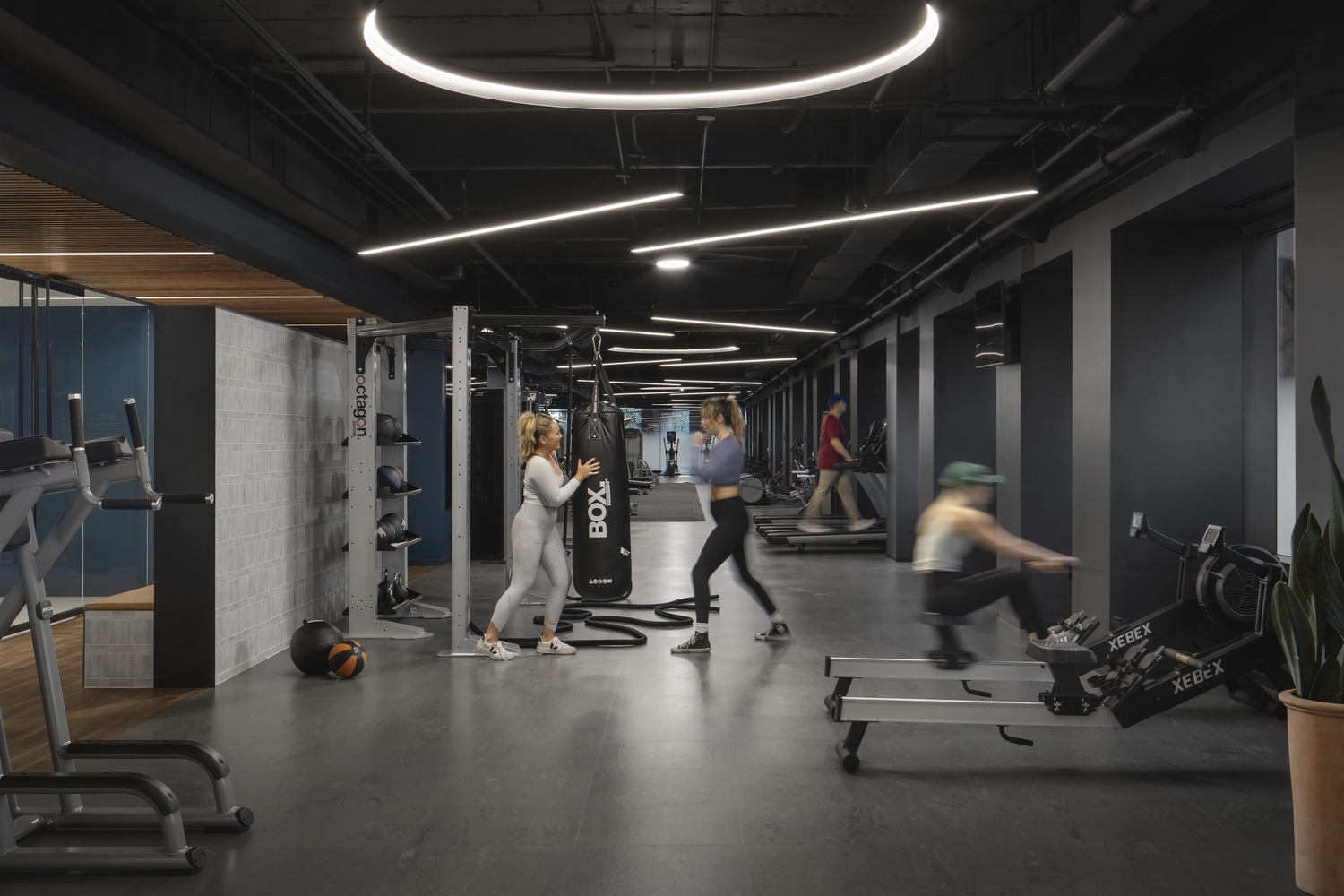
Confidetial Client | Photography by Andrea Calo
Applying the principle of Sustainable Revitalization positively influences the mental states associated with burnout, mental exhaustion, and absenteeism, heightening social connections, satisfaction levels, talent recruitment, and retail sales. The measurable outcomes of Sustainable Revitalization can be gauged by assessing positive change in these areas.
Conclusion
The Experiential Dimension, prefigured by the Spatial Dimension, organically segways to the Relational Dimension, our next post in this series as we move beyond human-centered design. Curious? Stay tuned.

Valerie Jardon
Managing Director, Strategy

Dr. Sally Augustin, pHD
Director of Research
With contributions by Holly Jeffers, Shane Smith, Philip Metzger, Andrea Benatar, Jessica Stoffers, Clark Pickett, Emma Morris, Carlotta Dove, Alyssa Alvarez, Gary Bouthillette, Diana Ruiz, Darwen Hinton, John Hopkins, Helena Keeling, Bhumi Patel
